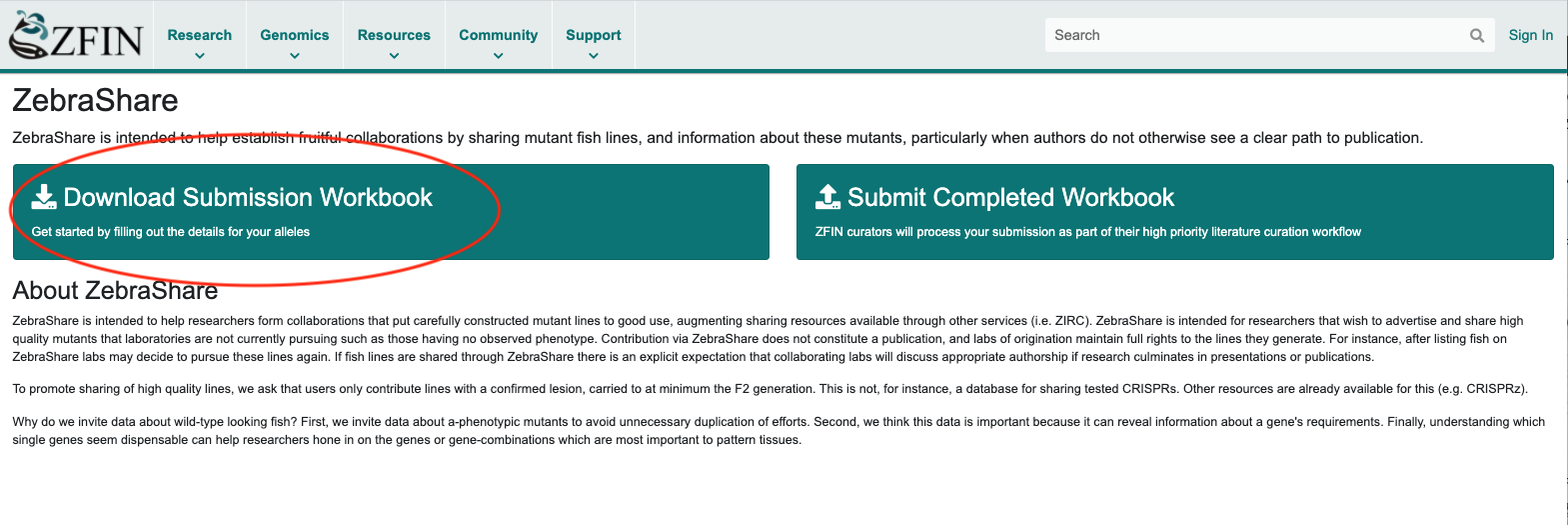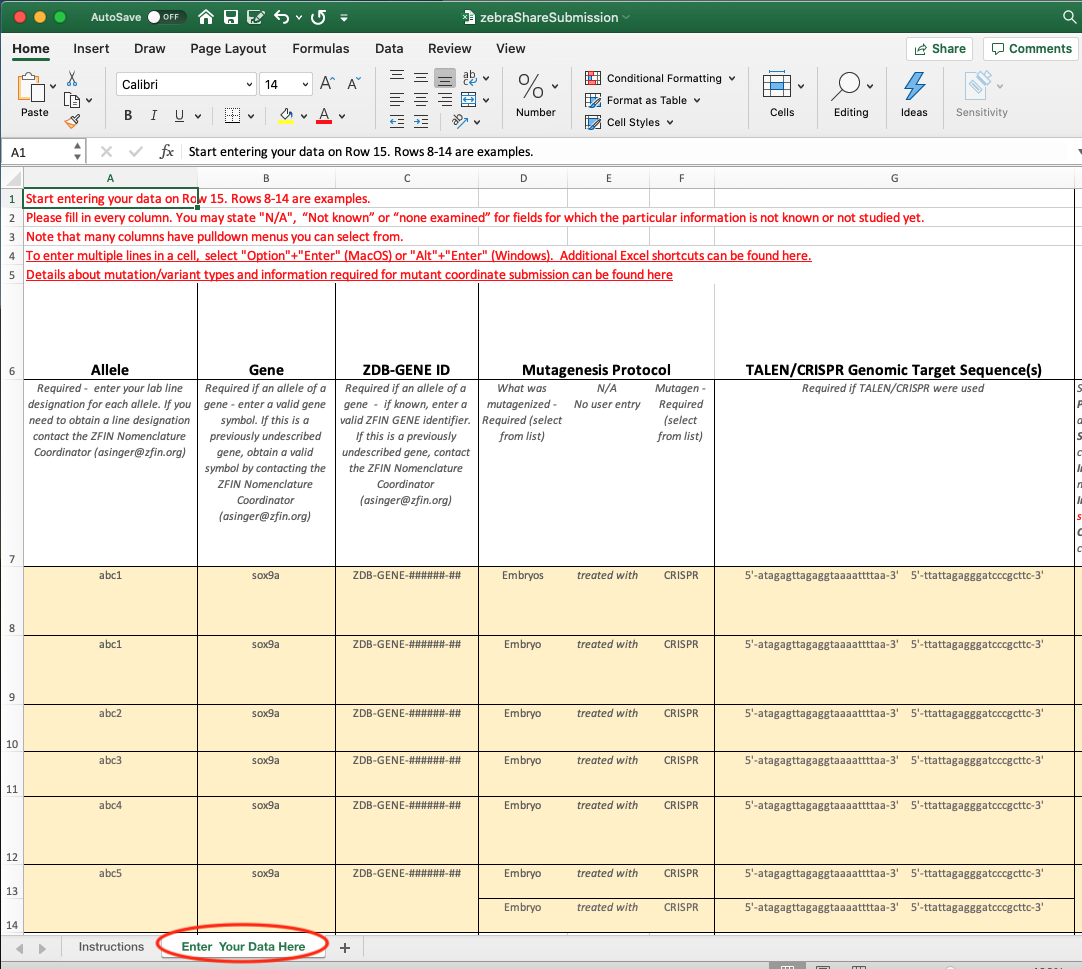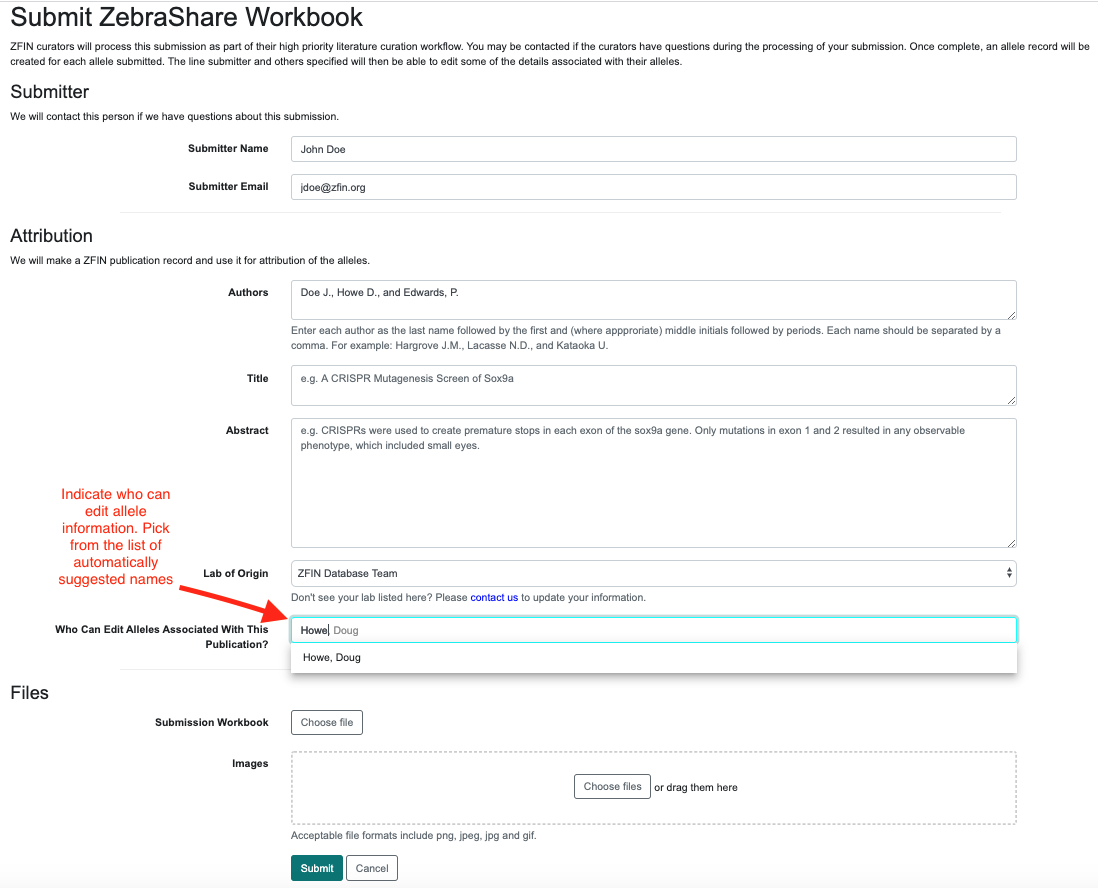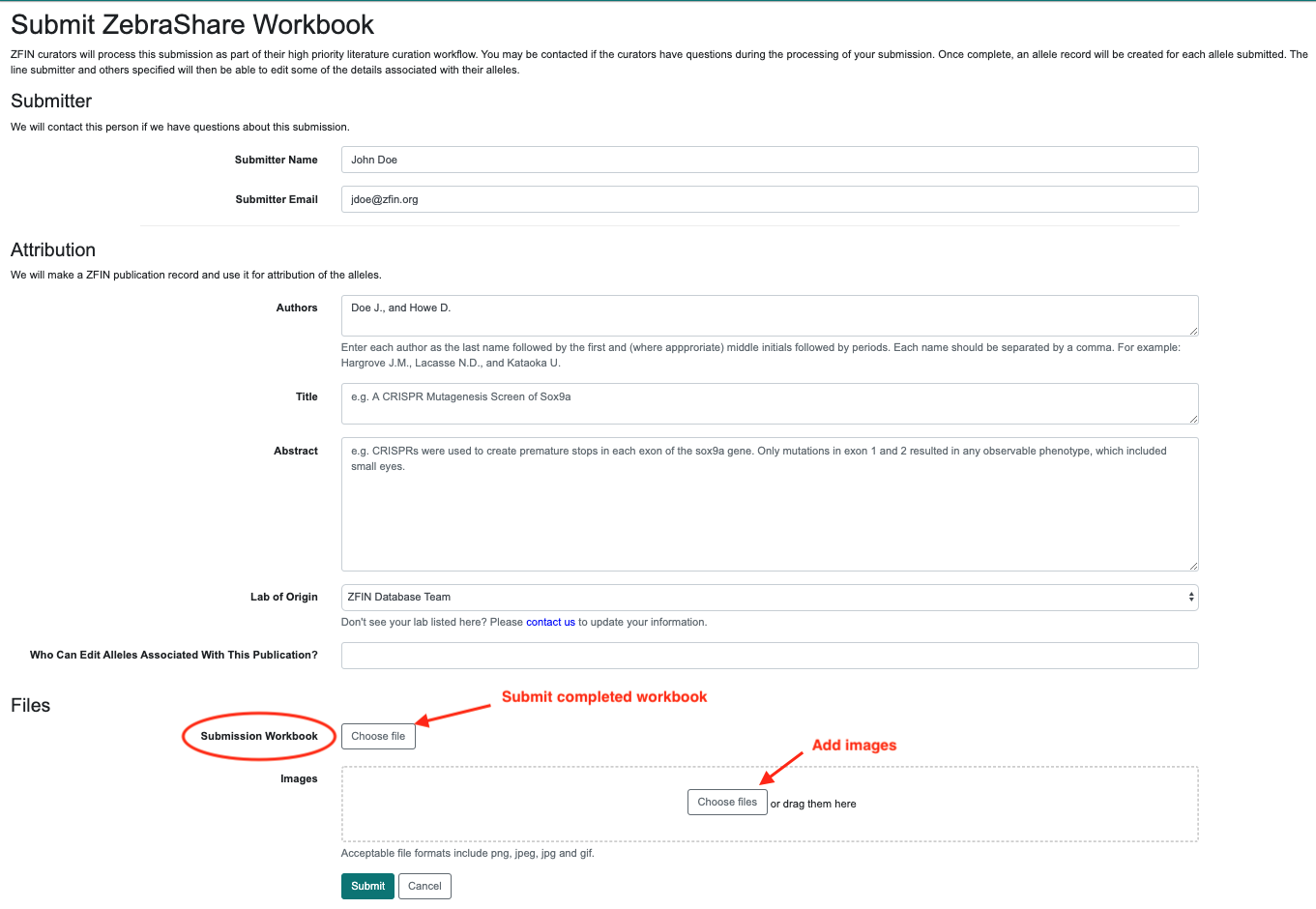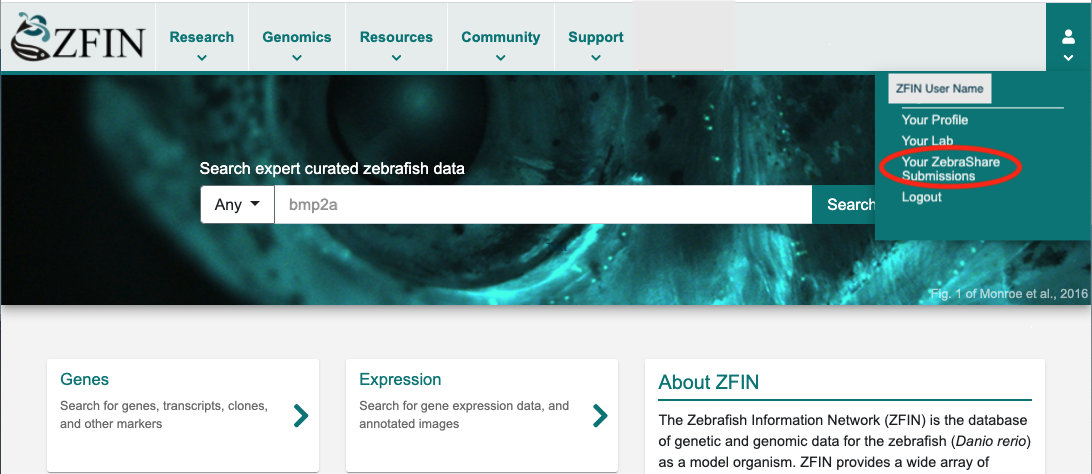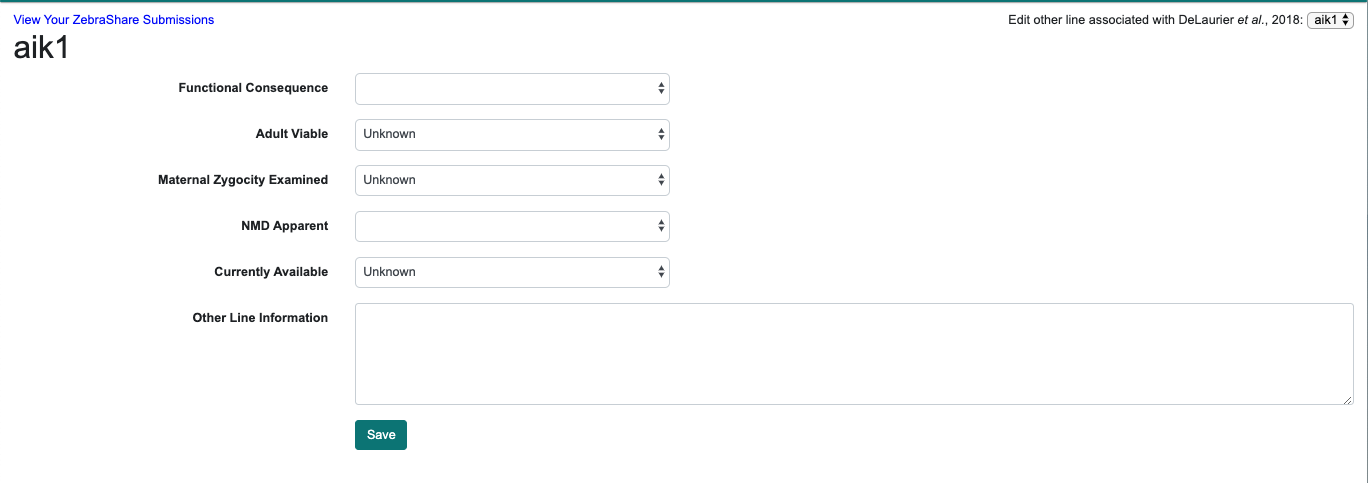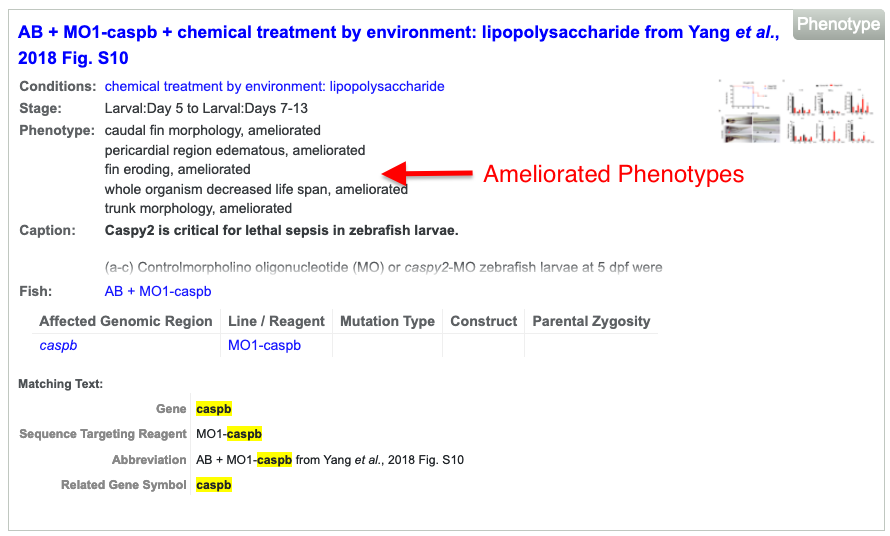About ZebraShare
ZebraShare is a resource for researchers to share information about and advertise high quality mutant fish lines that they have generated but are not currently studying, such as those with no observed phenotype.
This information will help prevent unnecessary duplication of effort between labs. Understanding which single genes seem dispensable will also help researchers converge on genes or gene combinations which are developmentally important.
We ask that you share well-characterized lines with a confirmed lesion, carried to at minimum the F2 generation.
Contribution via ZebraShare does not constitute a publication, and labs of origination maintain full rights to the lines they generate. After listing fish on ZebraShare, labs may decide to pursue these lines again. If fish lines are shared through ZebraShare, there is an explicit expectation that collaborating labs will discuss appropriate authorship if research culminates in presentations or publications.
All ZebraShare alleles will be publicly visible at ZFIN.
For more details, visit the ZebraShare home page: https://zfin.org/action/zebrashare
How to submit data to ZebraShare:
- Go to the ZebraShare home page:
- Download the ZebraShare Submission Workbook
- Click on “Download Submission Workbook” on the ZebraShare page (Fig. 1)
- Fill out the ZebraShare Submission Workbook
- Go to the “Enter Your Data Here” tab in the Workbook and fill out all the details for your alleles (Fig. 2)
- Details about mutation/variant types and information required for submitting mutant coordinates can be found here
- Submit the Submission Workbook to ZFIN
- Log into ZFIN and return to the ZebraShare page
- Click on the "Submit Completed Workbook" button (Fig. 3)
- Fill out the "Submit ZebraShare Workbook" Form:
- Your name and e-mail address will be automatically filled in based on your ZFIN login.
- Fill in the authors, title, and abstract for your submission
- Specify who is authorized to edit the alleles (Fig. 4)
- Attach the ZebraShare Submission Workbook and any additional image files to the Form (Fig. 5). Acceptable file formats are png, jpeg, jpg and gif.
- Submit the form, which will automatically create a ZFIN submission record.
- After your data submission is complete:
- You will receive a notification that your data was successfully submitted, with a link to your ZebraShare “publication” (Fig. 6)
- ZFIN curators will process this submission as part of their high priority literature curation workflow.
- You may be contacted if curators have questions during the processing of your submission.
- An allele record will be created by ZFIN curators for each allele submitted.
- The line submitter and others they specify will be able to add/edit some of the details associated with their alleles.
- To access your submission, sign in to ZFIN. A user icon will appear on the right-hand side of the ZFIN page. Hover the mouse over the icon to see a menu. Select “Your ZebraShare submissions” from the menu. (Fig. 7)
- On the “Your ZebraShare submissions” page, you will see the “publication ID” of your submission, and links to “View” or “Edit” the alleles you submitted (Fig. 8)
- Click on “Edit” to edit these fields for your mutant (Fig. 9):
- Functional consequence
- Adult viable
- Maternal zygosity examined
- NMD Apparent
- Currently available
- Other line information (free text)
How to find ZebraShare alleles and submissions in ZFIN:
You can find all ZebraShare alleles in ZFIN using single-box search. In the Mutation/Tg category, select the “Is ZebraShare” option:
You can find all ZebraShare submissions in ZFIN using single box search. In the Publication category, go to the Journal option, and select ZebraShare:
ZFIN would like to thank April De Laurier and Jared Talbot for their help in developing ZebraShare.
You can contact us at zfinadmn@zfin.org
Figure 1. Download the Submission Workbook from the ZebraShare home page.
Figure 2. Go to the “Enter Your Data Here” tab in the Submission Workbook and fill out the details for your mutant(s).
Figure 3. When ready to submit your data, return to the ZebraShare page, log in, and click on “Submit Completed Workbook”.
Figure 4. Fill out the “Submit ZebraShare Workbook” form.
- Your name, e-mail address and lab will be visible in the “Submitter” and “Lab of Origin” sections.
- Fill in the authors, title, and abstract for your submission.
- Specify who can edit information about your submission.
Figure 5. Attach your Submission Workbook and images (in png, jpeg, jpg or gif format) in the “Files” section. Click “Submit” to submit your workbook to ZFIN.
Figure 6. You will receive notification that your data submission was received, with a link to your ZebraShare “publication”.
Figure 7. You can access, view and edit your ZebraShare submissions from the ZFIN home page when logged in.
Figure 8. You can View or Edit your submission following the appropriate link.
Figure 9. Click on “Edit” to edit information about your mutant.
Dear Zebrafish Community Members,
Do you have a colleague who is an outstanding leader is the zebrafish community? Are you someone who is passionate about the future of zebrafish research?
The International Zebrafish Society (IZFS) is accepting nominations for the 2020 election for new members of the Board of Directors. The Board acts on the behalf of IZFS to guide the activities and direction of the Society. This is an excellent opportunity to get involved!
Zebrafish community members are invited to submit nominations by Monday, April 13, 2020 for the following positions on the IZFS Board of Directors.
* President-Elect
* Treasurer
* Asia/Pacific Regional Director (1 vacancy)
* Europe/Mediterranean Director (1 vacancy)
* US/Canada Director (2 vacancies)
Each elected Board member is expected to commit to a 3-year term starting on July 1, 2020.
You may nominate candidates here: https://forms.gle/bibWCiPAMQKnN7MV9 into your browser.
Nominees must be IZFS members in good standing who have paid their 2020 dues. We welcome nominations of individuals who are forward thinkers, strategic planners, and dedicated volunteers active in the zebrafish community. Self-nominations are also welcome. If you have not renewed your membership or are not a member of IZFS, please click below to join today or renew online in order to be considered for Board nomination or to vote in the election!
Join now: https://www.izfs.org/membership/join
Renew now: https://www.izfs.org/membership/renew
Nominations will be reviewed by the IZFS Nominations Committee who will determine the final ballot in accordance with IZFS bylaws. Thank you in advance for your nominations.
Sincerely,
IZFS Nominations Committee
Dear colleagues,
Due to the Covid-19 pandemic, resource distribution and diagnostic health services at the Zebrafish International Resource Center (zebrafish.org) have been suspended until we are able to resume operations again. All requests and inquiries will be logged in the order received, and we will contact you as soon as possible once operations resume. Emergency consultations for health, husbandry, or aquaculture will be addressed as soon as possible.
Your ZIRC team
Dear colleagues,
Due to the Covid-19 pandemic, resource distribution and diagnostic health services at the Zebrafish International Resource Center (zebrafish.org) may be delayed. All requests and inquiries will be addressed in the order received, and we will contact you when normal operations resume. Emergency consultations for health, husbandry, or aquaculture will be addressed as soon as possible.
Your ZIRC team
The ZFIN team has launched a new, easier way to keep up to date with our posts for Jobs, Meetings, News and Protocol on https://wiki.zfin.org. In the past, users needed accounts on the wiki, and had to login and choose which pages to Watch. Now, we have created a mailing list that anyone can subscribe to and receive updates.
You can subscribe and manage your subscription to the list at https://lists.uoregon.edu/mailman/listinfo/zfin-posts.
Best,
The ZFIN technical team
Phenotype annotations in ZFIN include morphological alterations and changes in gene expression in mutant or knockdown fish as well as fish exposed to various experimental treatments. Often, new insights can come from understanding what genes or treatments modify the phenotype of specific mutants. ZFIN records phenotypic modification (ie genetic interaction) as either “ameliorated” (partial or complete rescue) or “exacerbated” (made worse).
These genetic interaction annotations are currently best found in ZFIN using the single box search.
Example 1: Filtering approach for ameliorated phenotypes
- Go to the ZFIN single box search page (https://zfin.org/search)
- Select “Phenotype” from the pulldown menu of data types
- Search for “ameliorated”
At this point all the phenotype results with ameliorated phenotypes are shown. On 3/5/2020 there are 2470 records. - An example phenotype result showing the ameliorated phenotypes
- From there, use the filters on the left side of the search results page to focus the result set on results of interest.
- You can filter by:
a. Phenotypic Gene: the disrupted gene involved in the phenotype
b. Phenotype Statement: the phenotype trait, like “eye decreased size”
c. Stage: the developmental stage at which the phenotype was observed
d. Manifests In:
anatomy: the anatomical structure affected in the phenotype
biological process: the biological process affected in the phenotype
cellular component: the cellular component affected in the phenotype
molecular function: the molecular function affected in the phenotype
misexpressed gene: genes having altered expression as part of the phenotype
e. Genotype: the genotype involved in the phenotype
f. Sequence Targeting Reagent (STR): morpholinos, TALENs or CRISPRs that were involved in the phenotype
g. Is Monogenic: Yes or No..indicates if there is only one affected gene
h. Conditions: the experimental treatment involved in the phenotype
i. Has Image: only include results that have image
The same basic approach can be used for exacerbated phenotypes by searching for “exacerbated” rather than “ameliorated”
Example 2: Searching for ameliorated phenotypes for the fkrp gene
- Go to the ZFIN single box search page (https://zfin.org/search)
- Select “Phenotype” from the pulldown menu of data types
- Search for “fkrp ameliorated”
- On 3/5/2020 there are 24 ameliorated phenotypes involving the fkrp gene
- You can then use the filters on the left side of the results to further focus the result set on records of interest.
- The same basic approach can be used for exacerbated phenotypes. Note that fkrp does not have any exacerbated phenotypes.
- Example: Search for “atg5 exacerbated”
